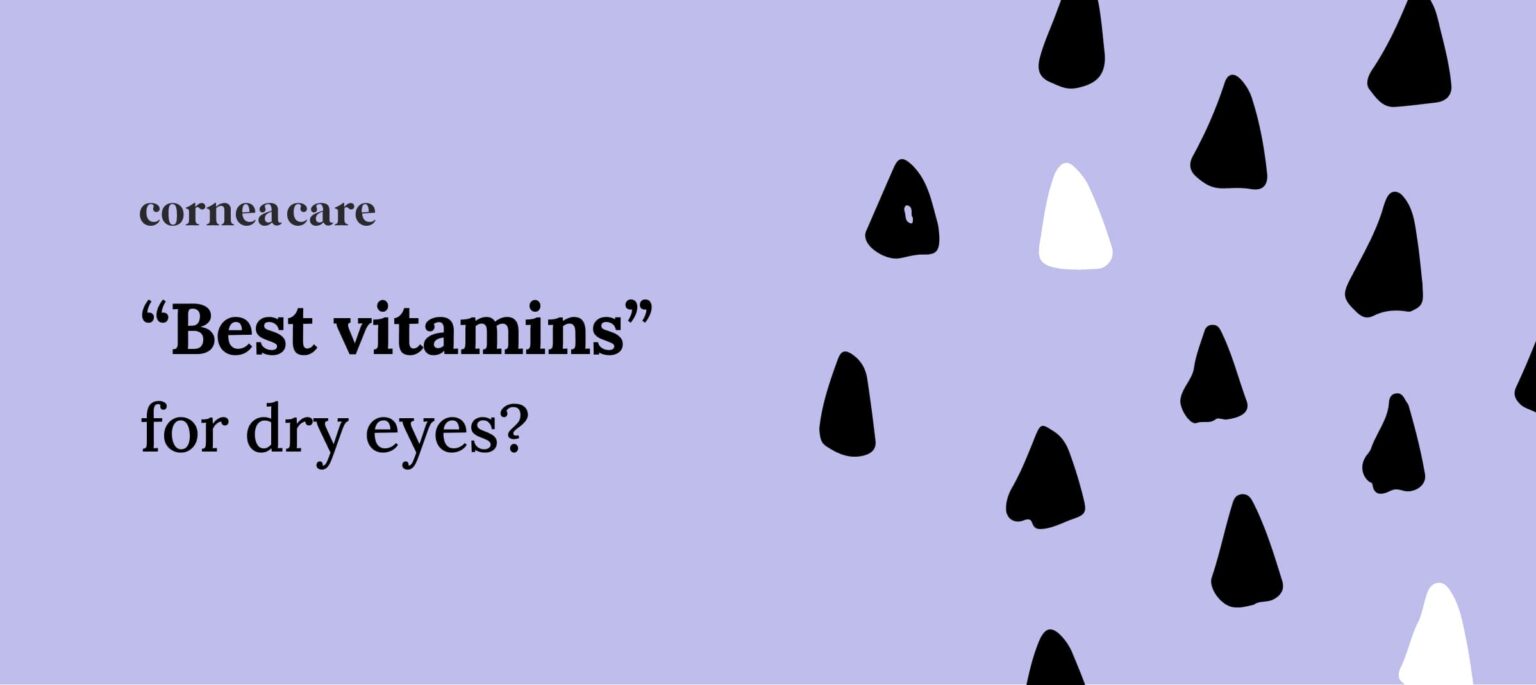Key points
- In addition to artificial tears and eyelid hygiene, “what you eat” can significantly impact your dry eye treatment.
- Eating a balanced diet with protein, carbs, essential fatty acids, vitamins and minerals, and drinking enough water is beneficial for the eyes, mind and body.
- Oral supplements can help address any deficiencies in your diet, and make sure you get all the essentials your body needs.
Keywords
Antioxidants, dry eye disease, omega-3 fatty acids, supplements for dry eye, vitamin A
Taking the first step
When people think of dry eye treatment, they typically think of eye drops and warm compresses. But did you know that your diet can make a significant impact on your dry eye symptoms and treatment? Unfortunately, nutrition is seldom addressed in a dry eye treatment regimen. This is likely because it takes time and effort for the eye doctor (ophthalmologist or optometrist) to explain the impact of nutrition, and even more effort for the patient to implement and stick with the nutritional plan. Not only is good nutrition important for the mind and body, but it’s also crucial for eye health.
We get it. It’s really hard to eat a balanced diet with our busy lifestyles. But you should certainly make an effort to do so, and if you feel like you’re falling short, oral supplements can help with any deficiencies.
What is dry eye disease
Before diving into eye vitamins and supplements, let’s cover some dry eye basics. Dry eye disease (DED) is also known as dry eye syndrome, keratoconjunctivitis sicca and ocular surface disease.1 The classic symptoms of dry eye are blurry vision, gritty sensation, light sensitivity, watery eyes, dryness, stinging or burning, and red eyes.
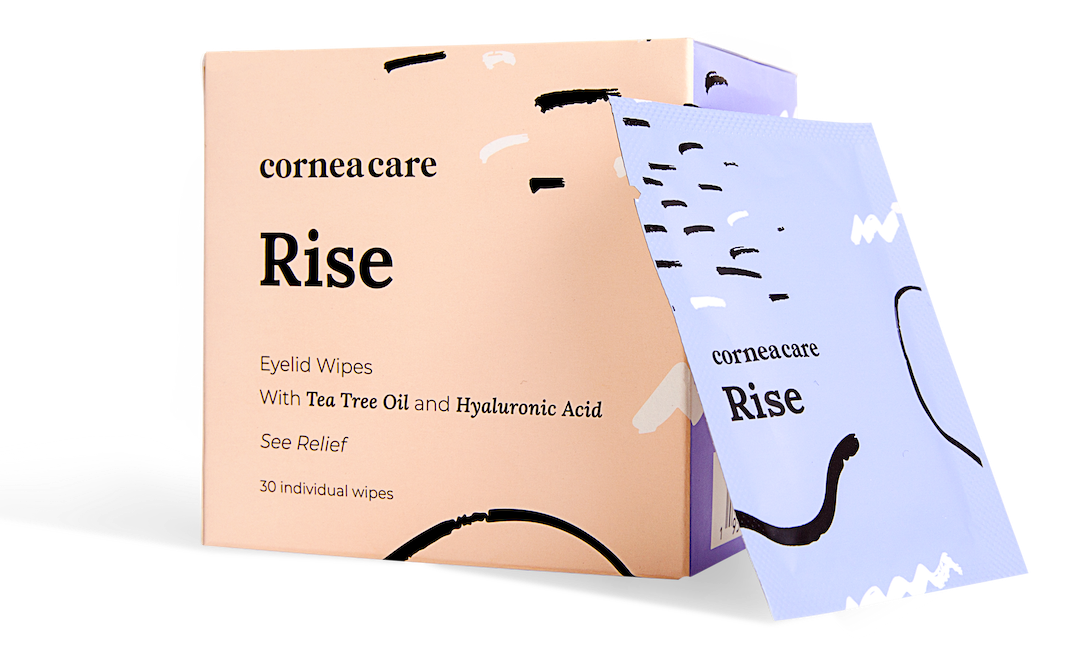
Rise
Eyelid Wipes
Perfect for eye dryness, itching, burning, and crusting/flaking of eyelashes. Free shipping 📦
Try today - $25
We typically break down the causes of DED into two categories: aqueous deficient and evaporative. With aqueous deficient DED, your lacrimal glands do not produce enough natural tears to lubricate the eye’s surface (the cornea and conjunctiva). With evaporative DED, your body’s tear production is normal, but the tears evaporate too quickly. Most forms of DED are usually a combination of both aqueous deficient and evaporative, leading to tear film dysfunction.
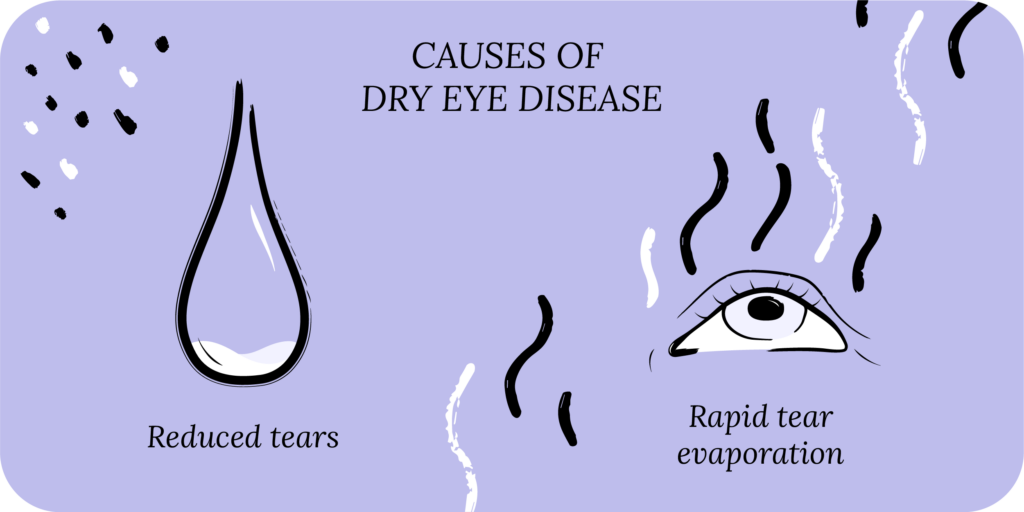
Environmental factors, such as low humidity, high winds and air pollution can worsen dry eye symptoms. Lifestyle risk factors for dry eye patients include extended use of digital screens, wearing contact lenses, poor diet, and smoking.
DED can affect you physically, emotionally, financially and even socially. It’s therefore important to start a treatment plan to improve your symptoms, and prevent long-term side effects and eye conditions from chronic DED.
Basics of dry eye treatment
The treatment of dry eye should address your eye’s surface, but also take into consideration your overall eye health, mind, body, lifestyle and environment. Lubricating eye drops can help augment your tear production, while eyelid hygiene can stabilize your tear film by treating meibomian gland dysfunction and reducing tear evaporation.
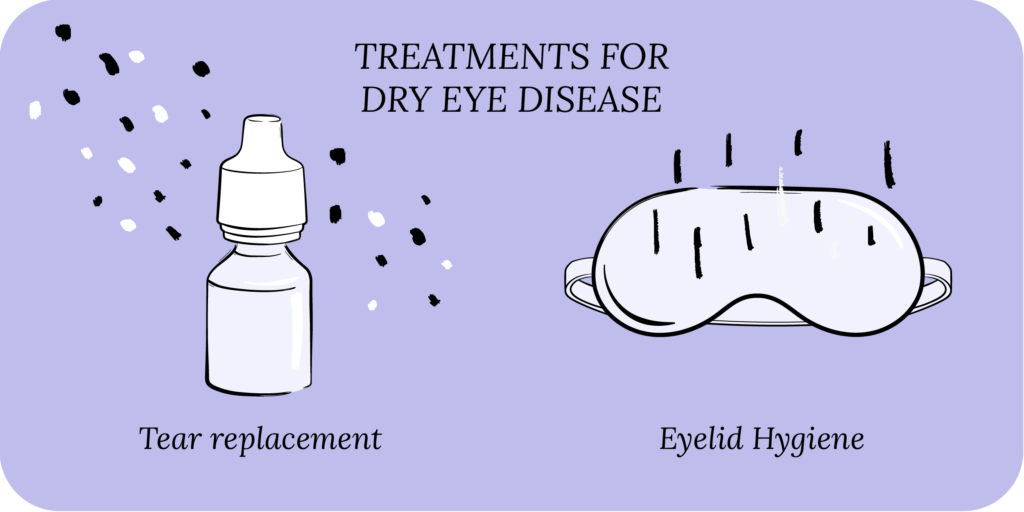
The treatment options for dry eye include over-the-counter (OTC) eye drops (artificial tears), gels, ointments and eyelid hygiene (warm compress and eyelid wipes). Eating a well-balanced diet and drinking lots of water can help, as can taking an oral dry eye supplement. A humidifier and air purifier can reduce environmental risk factors in the house. In some cases of severe dry eyes, a person may require prescription eye drops and in-office ophthalmic procedures.
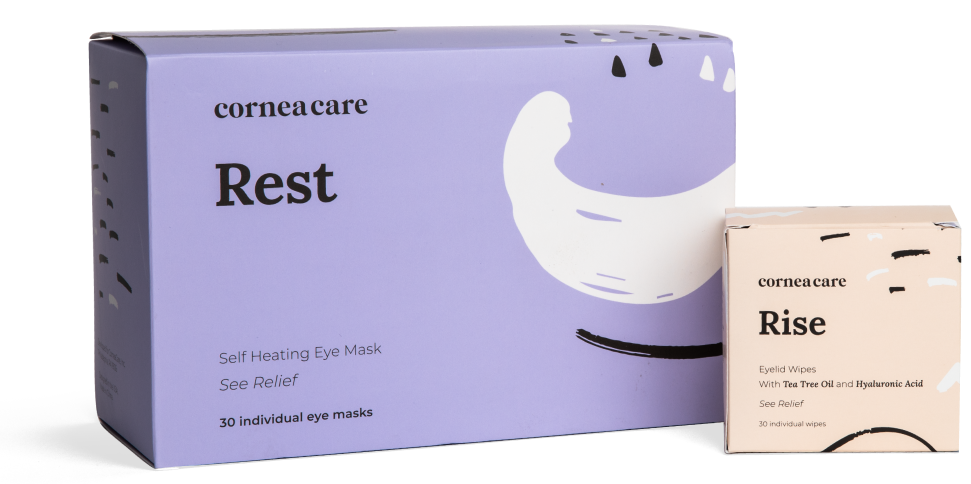
Foundation
Eyelid Hygiene Plan 2
Perfect for eye dryness, burning, itching, crusting/flaking of eyelashes and inflamed eyelids. Free shipping 📦.
Try today - $45
Nutrition and dry eye disease
Nutrition is essential for all aspects of life, including your eyes, mind and body. However, the importance of nutrition in eye health and eye care is seldom addressed. Not only can good nutrition provide you with a healthy foundation for eye health, but it can also amplify the positive effects of other treatments. It all starts with eating a healthy, balanced diet containing proteins, carbs, essential fatty acids, vitamins and minerals, and drinking lots of water.
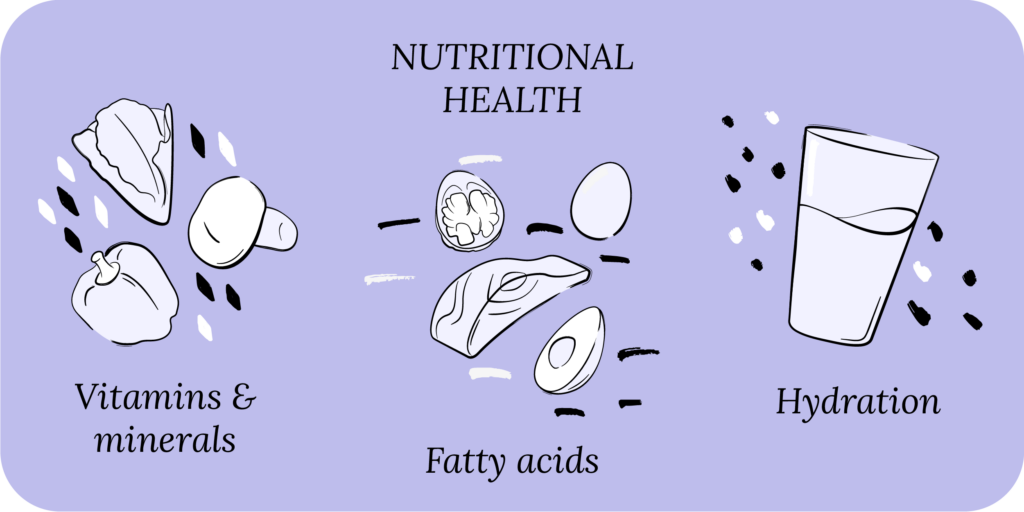
We cannot stress the importance of nutrition in treating DED enough.2 In fact, the lack of certain vitamins, such as vitamin A, can cause dry eye disease, and the lack of other nutrients can worsen dry eye symptoms. A healthy diet may be used to both prevent and treat DED. There is no “best” vitamin for dry eyes, but nutrients with antioxidant and anti-inflammatory properties are particularly important. These include vitamins A, E, C, D, B6, and B12, coenzyme Q10, zinc and copper, selenium, lactoferrin and curcumin. Eating foods with all these nutrients can sometimes be difficult, and this is where a dietary supplement can augment your diet and address any deficiencies.
Below we’ll cover some of the nutrients to look for in your diet and in your dry eye health supplement. These nutrients have many health benefits, but we’ve focused specifically on how they impact the eyes. We’ve also provided a limited list of foods that contain these nutrients.
Vitamins
- Vitamin A3 – plays a major role in growth and development of the surface of the eye. Long-term vitamin A deficiency can lead to conjunctival keratinization, and corneal scratches and infections. You can typically find vitamin A in meat, fruits and vegetables.
- Vitamins B6 and B12 – are involved in the proper functioning of your nerves and nervous tissue. DED may be a part of neuropathic pain, where your corneal nerves aren’t functioning properly, and your body doesn’t process pain correctly. Vitamins B6 and B12 may help promote proper nerve function. You can typically find vitamin B6 in chickpeas, non-citrus fruits, sweet potatoes, salmon and tuna. For vitamin B12, eat fortified cereals, dairy products, meat and fish.
- Vitamin C – is found in your tear film, and helps with antioxidation and wound healing of the ocular surface. Vitamin C can be found in citrus fruits, strawberries, cherries, tomatoes and broccoli.
- Vitamin D – helps decrease inflammation, fortify the ocular surface, stabilize the tear film, and increase tear production. For some sources of vitamin D, eat eggs, fish, mushrooms and fortified cereals. Your body can also make vitamin D from exposure to sunlight.
- Vitamin E – primarily serves as an antioxidant, but can also help with vitamin A absorption and protecting the membranes of the cells that make up the cornea and conjunctiva. You can find vitamin E in green vegetables, nuts, seeds, avocado, and fortified cereals.
Minerals
- Copper4 – helps with antioxidation and building strong connecting tissue which may improve the integrity of the ocular surface. Copper also binds zinc, and the two are often given together in supplements. You can find copper in shellfish, whole grains, beans, nuts, and dark leafy vegetables.
- Zinc – is an antioxidant and plays a major role in the functioning of cells in the retina (the back of the eye), and protects against age-related macular degeneration. You can find zinc in red meats, legumes, seeds, oysters, eggs and cheese.
- Selenium – serves as an antioxidant, and protects the surface of the eye. Meat, fish, seafood and cereals are good sources of selenium.
Essential fatty acids
Essential fatty acids, specifically omega-3 fatty acids, may be beneficial in treating DED.5 In addition to improving cardiovascular health, essential fatty acids are anti-inflammatory and improve the function of your nerves and nervous tissue. Omega-3 acids are either short chain or long chain. The short chains include alpha-linolenic acid (ALA), which can be found in flaxseed oil. The long-chain fatty acids include eicosapentaenoic acid (EPA) and docosahexaenoic acid (DHA), which are present in fish (tuna, salmon, trout and sardines) and fish oil, or in algal oil (derived from algae as a vegan option).
It’s important to note that the average diet consists mostly of Omega-6 fatty acids (found in vegetable oil). We typically consume 15 times more Omega-6s compared to Omega-3s. While Omega-6s are helpful in many ways, when you consume such a disproportionate amount compared to Omega-3s, it can actually cause inflammation. So it’s important to make sure you’re balancing your Omega-6s with Omega-3s. This is where an Omega-3 supplement can be helpful. For DED, you want supplements with a high Omega-3 dose, usually 2000mg or more, and more EPA than DHA.
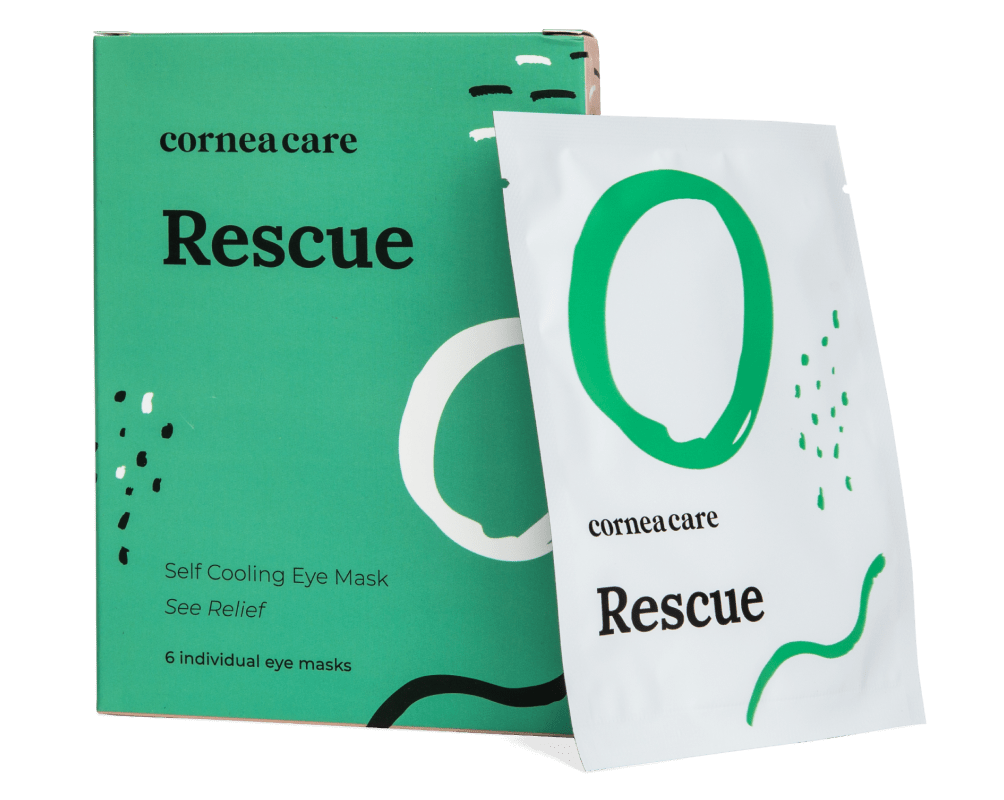
Rescue
Cold Compresses
Perfect for sudden flare-ups of eye dryness, pain, burning, and swollen/inflamed eyelids. Free shipping 📦.
Try today - $12
Other supplements
Carotenoids
Carotenoids are yellow, orange and red pigments typically found in plants.6 The most common types are alpha-carotene, beta-carotene, beta-cryptoxanthin, lutein, zeaxanthin, and lycopene. Your body can actually convert alpha-carotene, beta-carotene, beta-cryptoxanthin into vitamin A. Carotenoids function as potent antioxidants, and also help with visual function in the retina. You will typically find carotenoids in eye supplements protecting against age-related macular degeneration.
- Lutein and Zeaxanthin – play a role in the visual function of the macula, which is the part of the retina that is responsible for most of your vision. Because of their antioxidant properties, they may also help with reducing damage to the ocular surface. You’ll find lutein and zeaxanthin in green leafy vegetables.
- Lycopene – helps with antioxidation for the eyes and the body. The best source of lycopene is from “red” fruits and vegetables, including tomatoes, watermelon and grapefruit.
Amino acids & Proteins
- Taurine7 – is involved in the functioning of the retina, and also may help in protecting your ocular surface by protecting against highly concentrated tears (more salt than water), which is one of the features of DED. The best source of taurine is seafood and meat.
- N-acetylcysteine8 – is a potent antioxidant and can protect the retina and the ocular surface from oxidative damage. In fact, eye doctors sometimes prescribe compounded n-acetylcysteine as topical drops for severe dry eye cases. Good sources of n-acetylcysteine include meat, fish, grains, legumes, dairy products, broccoli, cauliflower and nuts.
- Lactoferrin9 – is found in natural tears, and helps protect the corneal surface from ultraviolet radiation. Lactoferrin may work synergistically with selenium to amplify antioxidation and protect the ocular surface. Lactoferrin is found in cow’s milk.
Curcumin
Curcumin is anti-inflammatory, antioxidant, and antimicrobial (fights infections), and promotes wound healing.10 All these play a vital role in protecting the surface of the eye. Curcumin protects against the immediate side-effects of DED, such as inflammation and oxidative injury. But it also prevents the side-effects of chronic DED, such as corneal scratches and infections. The best source of curcumin is turmeric, which is widely used as a spice and flavor.
Hyaluronic acid
Hyaluronic acid is a humectant, which means that it attracts water and promotes hydration and moisturization.11 This is important for your joints, skin, bones, and ocular surface. Some sources of hyaluronic acid include bone broth, rooster combs, soy-based foods, and starchy root vegetables. Hyaluronic acid can also be lab-grown.
How to use nutritional supplements
Nutritional supplements work best if consumed in a consistent daily dose. Generally, splitting the dose over two servings during the day (morning and evening) helps with absorption. You also want to take them after a meal, so after breakfast and dinner. Be sure to drink a full glass of water after taking your supplements to help digestion and maintain your body’s hydration. Nutritional supplements work best alongside other lifestyle changes.
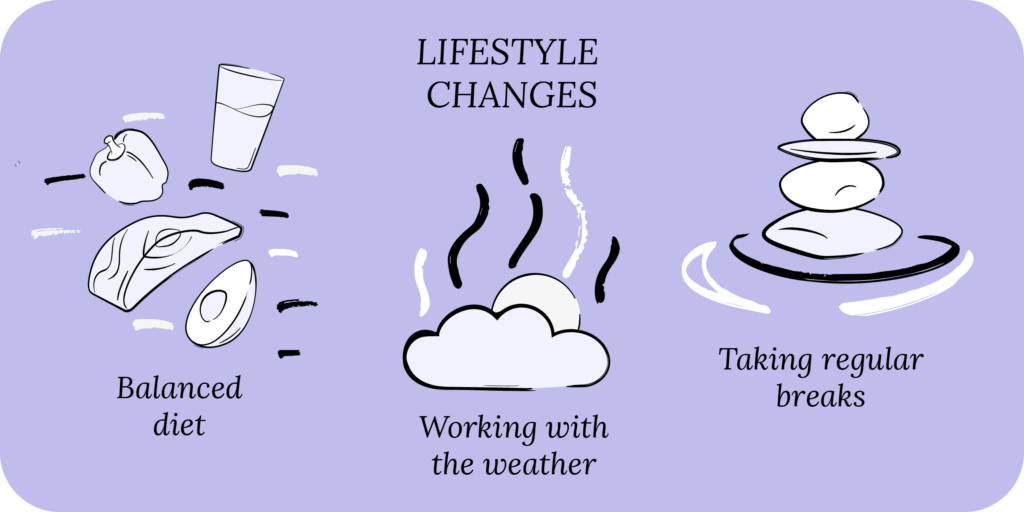
Putting it all together
Your diet plays a crucial role in your eye care. Just like with diabetes or high blood pressure, the first thing your primary care doctor tells you to do is make some lifestyle changes. It’s the same with DED. In addition to your environment and work-life, nutrition can make a big impact in DED.
By addressing your diet, you build the foundation for lasting relief. So do your best to eat a healthy, balanced diet containing proteins, whole grains, essential fatty acids, vitamins and minerals, and drink lots of water. Focus on nutrients with antioxidant and anti-inflammatory properties. If you need an extra boost, using a well-rounded eye health supplement can be a great addition to your dry eye treatment plan.
What’s next
We really think everyone should take our Dry Eye 101 course. Find it here!
If you’ve already taken it, amazing! Check out more articles in the Continuing Education section below.


